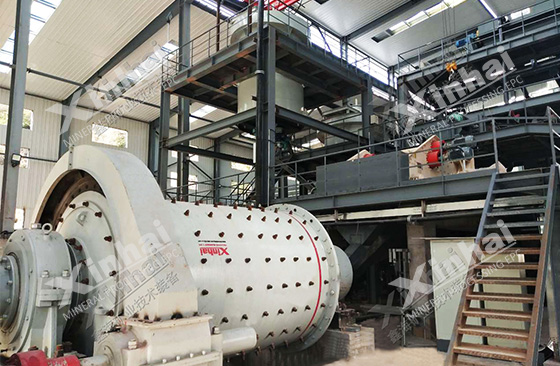
As a key equipment often used in metal ore beneficiation plants, ball mills can be used in the first, second, third or regrinding processes. The purpose of grinding is to dissociate and separate useful minerals and gangue minerals from each other, and secondly to provide separation process with suitable particle size for subsequent sorting operations. In actual production, the grinding operation often forms a closed circuit process with the classifying operation, so the too coarse ore particles in the grinding products may enter the regrinding process in the process for reprocessing, and the over-crushed minerals have no chance of recycling. In order to avoid the influence of crushed ore particles on mineral processing index and economic losses, it is necessary to understand the causes of over-crushed ore particles, and avoiding them from the source is an important way to solve this problem. The following will introduce you to the internal and external causes of over-crushing in the grinding process.

The internal cause is determined by the nature of the ore, mainly due to the difference in hardness, brittleness, grain size and even shape among different minerals. These factors will cause the mineral grinding rate is not consistent to cause over crushing.
Hardness difference: Ores are generally associated with other gangue minerals, and their hardness varies. During grinding, minerals with more severe hardness are difficult to grind, while those with less severe hardness are more likely to be ground. It is precisely because of the hardness difference that some minerals that are easily ground and over-crushed, while others with greater hardness are not ground enough.
Brittleness difference: the brittleness of minerals is also one of the important factors causing the over-crushing. Although some minerals are easy to be broken and ground, others are tough and not easy to be ground. As a result, brittle minerals are easily used to be ground in the grinding process, while other minerals do not meet the requirements of grinding particle size.
Particle size differences: there are particle size differences among different minerals. During the grinding process, minerals of different grain sizes are mixed together, and smaller minerals are ground faster, and larger minerals take a longer time. In this process, minerals with smaller particles are susceptible to over-crushing.
Shape difference: The shape of the ore also affects the grinding process. After the crushing process, some minerals have more uniform shapes, while some minerals show irregular or sharp shapes. This irregularly shaped ore is easier to grind, while evenly shaped minerals take longer and energy to meet the particle size requirements.

(Grinding process)
The above are the internal causes of some excessive crushing formed in the grinding process. In the actual production, these internal causes should be taken into account, and the grinding process should be carefully designed and controlled to ensure that various minerals can be effectively worn out without leading to excessive crushing or failure to meet the grinding requirements. In the production, the internal cause caused by the excessive crushing is easy to be ignored. In fact, internal factors will cause fluctuations in the properties of the ore. In the absence of timely adjustment, it can further affect the particle size distribution of the grinding process, which is obvious in the industrial production process. Therefore, it is very important to study the internal causes of mineral crushing and prove the selective grinding mechanism of minerals.
External factor mainly refers to the process parameters, operation parameters and operation level of each equipment, and steel ball filling system in the grinding process type composed of ball mill and classifying machine. The external cause directly reflects the power consumption, steel consumption, material consumption, investment and maintenance cost generated in the grinding process, so it is more daily attention and attention by the concentrator.

(Grinding process)
Process parameters: the parameters of grinding process mainly include the speed of grinding equipment, grinding medium, the flow rate of grinding medium, etc. These parameters can all affect the degree of ore crushing. Wrong parameter settings are highly likely to lead to problems such as overgrinding and undergrinding. Therefore, it is very important to set the correct parameters during the grinding process to control the ore particles.
Equipment operation parameters: Since grinding and classifying often form a closed circuit process, the parameters of equipment should pay attention to the parameters of grinding equipment and classifying equipment. The main operating parameters of equipment are equipment maintenance status, wear degree, equipment adjustment and calibration, etc. These parameters will not only affect the crushing effect, but also affect the overall production speed. Choosing the correct equipment operation parameters to ensure the normal operation and regular maintenance avoids the problem of excessive crushing.
Operation level of workers: the operation level and experience of technicians will also affect the effect of the grinding process. Experienced and skilled personnel can better control the grinding process flow and ensure that the ore is properly worn out.
Grinding medium supplement system: when the ball mill is used for grinding, the grinding medium steel ball plays the role of grinding the ore. Therefore, the number, size and filling amount of steel balls in the grinding process will affect the grinding effect. Inadequate steel ball supplementation may result in excessive grinding or undergrinding, thus requiring effective management and monitoring.

(Mineral Grinding Machine)
The above are the external causes of excessive crushing in the grinding process. The grinding process needs to be optimized and monitored by considering these factors to ensure that the ore can be properly crushed during the grinding process without the problem of excessive grinding. This often needs to be combined with operator training and equipment maintenance to ensure a stable and efficient operation of the entire mill process.
To sum up, in the process of grinding, the internal and external causes of excessive crushing need to be considered comprehensively. Taking these factors into account, the grinding process can be optimized more carefully to avoid resource waste and economic loss caused by excessive crushing, and improve product quality and process stability.
To find out more about our products and solutions, please fill out the form below and one of our experts will get back to you shortly.